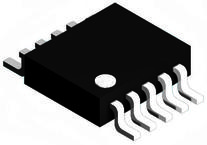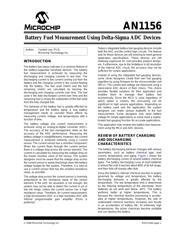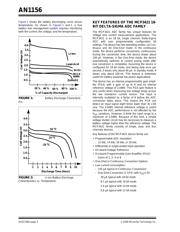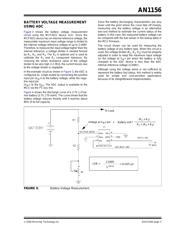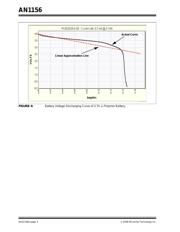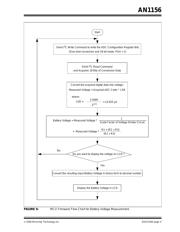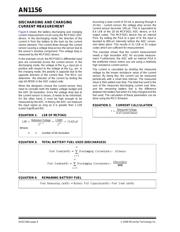herunterladen

© 2008 Microchip Technology Inc. DS01156A-page 1
AN1156
INTRODUCTION
The battery fuel status indicator is a common feature of
the battery-supported handheld devices. The battery
fuel measurement is achieved by measuring the
discharging and charging currents in real time. The
discharging current is the current coming out from the
battery and the charging current is the current flowing
into the battery. The fuel used (mAH) and the fuel
remaining (mAH) are calculated by tracking the
discharging and charging currents over time. The fuel
used is the total discharged current over time and the
remaining fuel is simply the subtraction of the fuel used
from the fully charged fuel.
The behavior of the battery fuel is greatly affected by
temperature and the battery aging. A true battery
management needs to consider these effects by
measuring current, voltage, and temperatures with a
function of time.
The battery voltage and current measurement is
achieved using an analog-to-digital converter (ADC).
The accuracy of the fuel management relies on the
accuracy of the ADC performance. Measuring the
battery voltage is straightforward. However, the current
measurement is achieved indirectly using a current
sensor. The current sensor has a resistive component.
When the current flows through the current sensor,
there is a voltage drop across the sensor element. The
current is calculated by measuring the voltage drop on
the known resistive value of the sensor. The system
designers must be aware that the voltage drop across
the current sensor is waste that brings down the battery
voltage budget for the system. Therefore, it is best to
use a current sensor that has the smallest resistance
value, as possible.
The voltage drop across the current sensor is inversely
proportional to the resistance value of the sensor
element. If the ADC bit resolution is not enough, the
system may not be able to detect the current in µA or
low mA range, unless the current sensor has a high
resistance value. Therefore, for current measurement,
a high bit resolution ADC or a high resolution ADC with
internal programmable gain amplifier (PGA) is
preferred.
Today’s integrated battery fuel gauging devices include
both the ADC and the control logic circuits. The feature
sets for these devices are still evolving to meet general
application specifications. These devices are still
relatively expensive for cost-sensitive product design-
ers. Furthermore, due to the limitations in bit resolution
of the internal ADC circuit, the accuracy may not be
sufficient for certain applications.
Instead of using the integrated fuel gauging devices,
some clever designers create their own fuel gauging
algorithm by using firmware for the microcontroller unit
(MCU). The current and voltage are measured using a
stand-alone ADC device of their choice. This choice
provides flexible solutions for their application and
enables them to manage their battery fuel
economically. Since the MCU is used regardless of
which option is chosen, the cost-saving can be
significant in high volume applications. Depending on
the battery used and the application, the system
designers can make various tradeoffs in the fuel
measurement. Some designers only need battery
voltage for simple applications or some need a sophis-
ticated fuel gauging function for accurate applications.
This application note reviews the battery fuel measure-
ment using the MCU and ADC devices.
REVIEW OF BATTERY CHARGING
AND DISCHARGING
CHARACTERISTICS
The battery discharging behavior changes with various
parameters, such as battery chemical type, load
current, temperature, and aging. Figure 1 shows the
battery discharging curves of several battery chemical
types. The battery discharging curve of most batteries
is almost flat until it reaches about 80% of its full range,
and then falls off sharply after that.
Since the battery’s internal chemical reaction is largely
governed by voltage and temperature, the battery
discharging behavior is greatly affected by the
temperature. The low temperature limit is determined
by the freezing temperature of the electrolyte. Most
batteries do not work well below -40°C. The battery
performs better at higher temperatures. This is
because the chemical reaction processing is acceler-
ated at higher temperatures. However, the rate of
undesirable chemical reactions increases and results
in an acceleration of battery life. At extremely high
temperatures, the active chemicals become unstable
and can destroy the battery.
Author: Youbok Lee, Ph.D.
Microchip Technology Inc.
Battery Fuel Measurement Using Delta-Sigma ADC Devices
Verzeichnis

